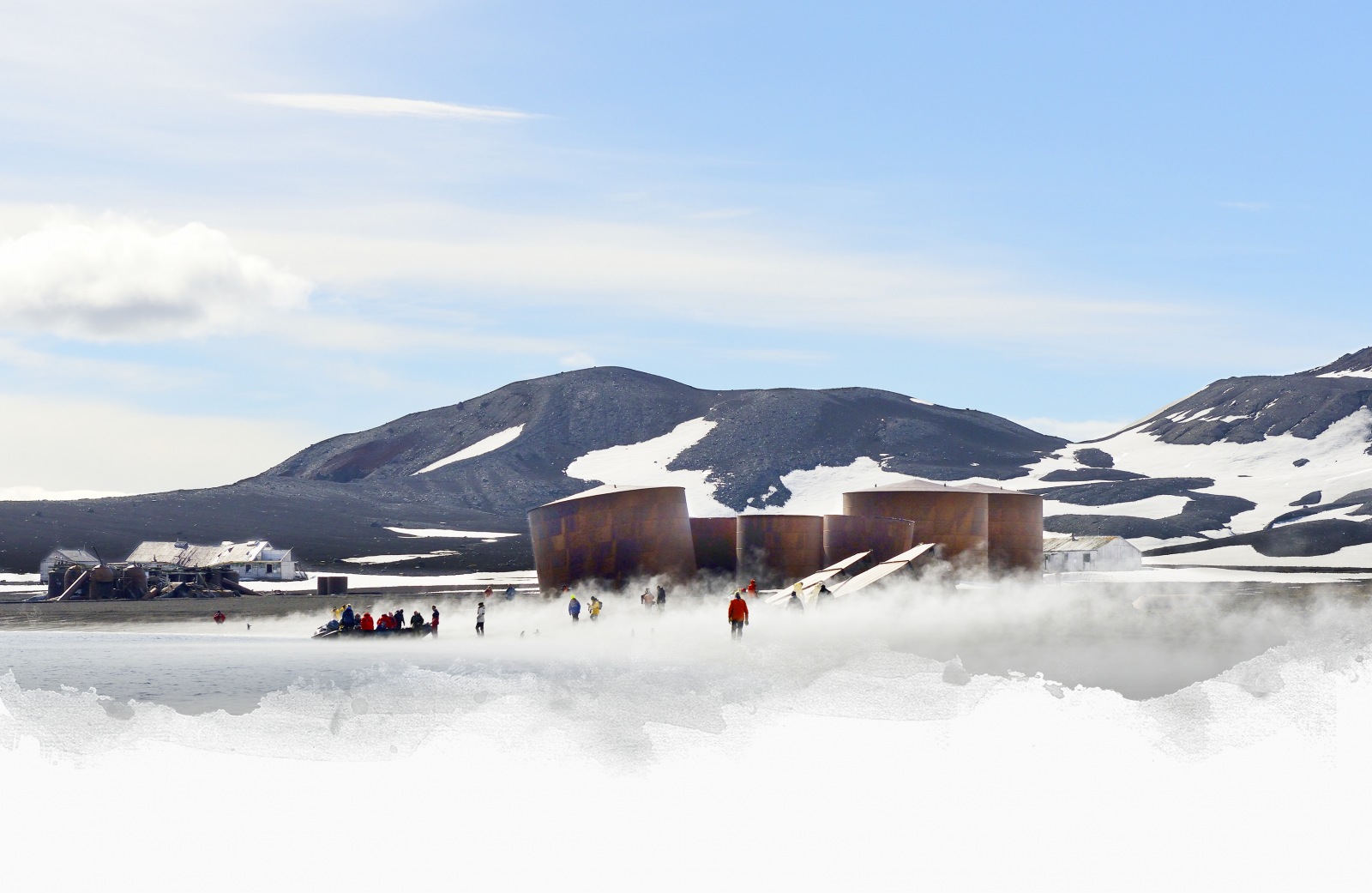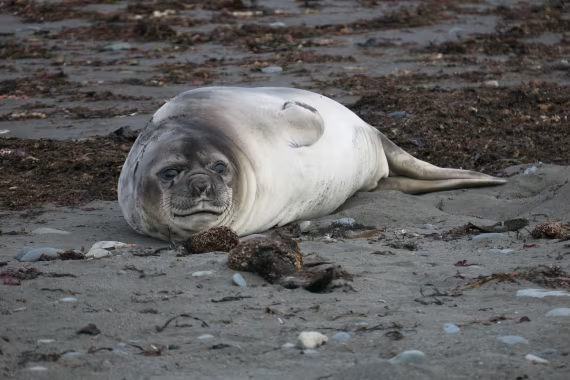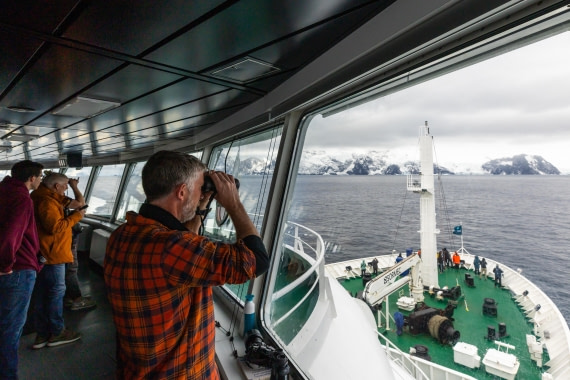Der Archipel besteht aus 11 Haupt- und mehreren kleineren Inseln. Sie sind recht gebirgig und zu mehr als 80% vergletschert. Die Inseln sind vulkanischen Ursprungs. Obwohl die Inseln vermutlich bereits zuvor entdeckt wurden, geht die erste gesicherte Sichtung der Inseln auf den britischen Seemann William Smith zurück, dessen Schiff 1819 bei der Umrundung von Kap Hoorn vom Kurs abkam. Wenig später besuchten Robbenjäger die Inseln auf der Suche nach Pelzrobben.

Derzeit haben wir keine Südliche Shetlandinseln Kreuzfahrten verfügbar.
Video
Neuester Blog und Kundenbericht

Von Stonington bis zu den südlichen Orkney-Inseln: Das Vermächtnis von Nathaniel Palmer
Nathanial Brown Palmer, auch bekannt als "Captain Nat", war ein amerikanischer Robbenfänger, Walfänger, Schiffskonstrukteur und Entdecker, dessen polares Erbe bis heute andauert. Palmer spielte eine entscheidende Rolle bei der Entdeckung und Benennung mehrerer berühmter Orte in der Antarktis, von denen Sie viele während einer Expeditionskreuzfahrt besuchen können.

Antarctica and My Old Friend, Ortelius: Passenger Story by Ann Lane
I was on the recent Antarctic trip on Ortelius, 16 Feb - 7 March. This has been my third expedition with Oceanwide, and I continue to be very impressed by the experiences.
Aktuelles Highlight und Tierwelt

Sehen Sie die Highlights, die Sie erleben können:

Sehen Sie die Highlights, die Sie erleben können:
Karte der Südlichen Shetlandinseln
Fan(tastic) photo
Bewertungen

Solo travel on Hondius Feb 2025 to Falkland, South Georgia and Antarctica. Saw 7 different Penguin species. Rockhopper, Gentoo, Magellanic, Macaroni, Adelie, Chinstrap & King Penguin. Saw different Whales as well. Minke Whale, Killer Whale / Orcas, Humpback Whales. Saw different birds. Saw different Seals. Fur Seals, Crab Eater Seals, Leopard Seals, Weddell Seals. Beautiful Landscape. Expedition Team great. Crew and Staff great. Love everything about my trip. Worth the money spent. Thanks for the trip log & slideshow. Food is great. Activities great. Love the zodiac cruise and landings.

My husband and I had an amazing 23 day journey to the Falklands + South Georgia + Antarctica! A huge part of this success came from the Oceanwide team — the ability of an expedition mindset allowed the team to be flexible and keep our best interests at heart. Whether that was prioritizing the safety of crew member during a med evacuation, or hopping out on the zodiacs earlier than expected because we came across a pod of 20+ orcas (1 of the biggest highlights of the trip!), the values of the staff speak volumes to the experience we had during our voyage. On and off board we had phenomenal service and communication. Everyone was incredibly kind, patient and knowledgable in their areas of expertise. We could not imagine going with another operator and had the trip of a life time! If you’re on the fence about booking, I say go for it!!! You have to experience the magic yourself :)

FAQ
Wie spät ist es auf den Südlichen Shetlandinseln?
Zeitverschiebungen können verwirrend sein, vor allem, wenn es sich um abgelegene Regionen der Welt handelt, in denen es nur wenige oder gar keine ständigen Einwohner oder Menschen gibt. Die Südliche Shetlandinseln bilden da keine Ausnahme. Die Standardzeit auf den Südliche Shetlandinseln ist die chilenische Standardzeit (GMT - 3). Das bedeutet, dass es um 12 Uhr mittags auf den Südliche Shetlandinseln 3 Uhr nachmittags in London oder 7 Uhr morgens in New York City ist.
Es ist zu beachten, dass in einigen der Forschungsstationen auf den Südliche Shetlandinseln aus betrieblichen Gründen andere Zeiten gelten können. Während Ihrer Expeditionskreuzfahrt mit uns folgen Sie der Schiffszeit, unabhängig von Ihrem Aufenthaltsort. In der Antarktis ist dies die argentinische Zeit (GMT - 3).
Wie ist die Temperatur und das Wetter auf den Südshetlandinseln?
Das Klima in diesem Gebiet ist typischerweise sehr kühl und entspricht dem Rest der nördlichen Antarktischen Halbinsel: Die durchschnittliche Sommertemperatur erreicht nur 1,5 Grad Celsius, und die typische Wintertemperatur liegt bei -5 Grad Celsius.
Selbst im Sommer sind die Süd-Shetland-Inseln noch zu 80 Prozent mit Eis und Schnee bedeckt. Es ist feucht und oft bewölkt, und die sonnigsten Tage werden in der Regel von kälteren Temperaturen begleitet. Daher sollte jeder, der eine Expeditionskreuzfahrt zu den Süd-Shetland-Inseln unternimmt, die richtige Kleidung mitbringen.
Welche Wildtiere kann ich auf den Südlichen Shetlandinseln sehen?
Bei einem Besuch auf den Süd-Shetland-Inseln findet man überraschend viel Leben in einer so rauen Umgebung. Die Tierwelt der Süd-Shetland-Inseln wie Robben, Pinguine und Seevögel nutzen das umliegende Wasser als Futterplatz und können oft vom Kreuzfahrtschiff aus beobachtet werden. An Land gibt es viele Beispiele für die Vegetation, darunter Algen, Flechten und Moose. Dies macht deutlich, dass das Leben auch an den unwirtlichsten Orten einen Weg finden kann.
Wie viele Menschen leben auf den Südlichen Shetlandinseln?
Wie viele Menschen auf den Süd-Shetland-Inseln leben, ist sehr schwer zu sagen. Die Forschungsstationen haben im Winter - wenn überhaupt - nur eine Notbesatzung. In den Sommermonaten wimmelt es nur so von Wissenschaftlern und Hilfskräften.
Wem gehören die südlichen Shetlandinseln?
Die Süd-Shetland-Inseln stehen nicht unter der Kontrolle einer Nation. Stattdessen erlaubt der Antarktisvertrag allen Unterzeichnern, die Region für alle nicht-militärischen Zwecke zu nutzen. Dies hat dazu geführt, dass 13 Länder Forschungsstationen und Feldlager eingerichtet haben. Vor der Unterzeichnung des Antarktisvertrags wurden die Inseln von Großbritannien, Argentinien und Chile beansprucht.
Welche einzigartigen Merkmale haben die südlichen Shetlandinseln?
Die Süd-Shetland-Inseln sind vulkanisch, überwiegend gebirgig und zu etwa 80 Prozent vergletschert. Auf einer Reise zu den Süd-Shetland-Inseln haben Besucher oft die Möglichkeit, Pinguine und Robben zu sehen. Ein Highlight ist immer die Deception Island, die abgesehen von spanischen und argentinischen Forschungsbasen unbewohnt ist. Die Gletscher und die steilen Gipfel auf der Ostseite der Insel bieten eine anspruchsvolle Umgebung für Wanderungen. Mit dem Kajak kann man auch Port Foster erkunden - die überflutete Caldera von Deception Island.
Über Kreuzfahrten zu den Südlichen Shetlandinseln
Wetter auf den Südlichen Shetlandinseln
Seien Sie auf Ihrer Kreuzfahrt zu den Südlichen Shetlandinseln auf kühles Wetter vorbereitet. Die Durchschnittstemperatur in den Sommermonaten erreicht nur etwa 1 bis 2 °C, wobei der Wind, der Ihre Körperwärme abtransportieren kann, noch nicht einmal berücksichtigt ist.

Fakten über die Südlichen Shetlandinseln
- Wenn es in der Antarktisregion ein geschäftiges kosmopolitisches Zentrum gibt, dann sind es die Südlichen Shetlandinseln. Auf den Inseln gibt es 10 Stützpunkte, die ganzjährig bewohnt sind, und weitere 8, die in den Sommermonaten genutzt werden.
- Die Südlichen Shetlandinseln bestehen aus vielen kleinen Inseln und Felsen sowie 11 Hauptinseln – Clarence, Deception, Elephant, Greenwich, King George, Livingston, Low, Nelson, Robert, Smith und Snow.
- Die Insel Deception gilt als aktiv und stellt ein „erhebliches vulkanisches Risiko” dar.
- Nur etwa 3 % der Inseln sind entlang der Küsten eisfrei. Dort finden Sie während Ihres Urlaubs auf den Südlichen Shetlandinseln das gesamte Leben der Inseln – einschließlich der Menschen.
- Der berühmte Entdecker Shackleton und seine Crew überlebten mehr als vier harte Monate auf Elephant Island.
- 12 verschiedene Länder haben Stützpunkte auf King George Island – Argentinien, Brasilien, Chile, China, Ecuador, Deutschland, Polen, Russland, Südkorea, Uruguay und die USA.
- Die Inseln wurden ursprünglich am 19. Februar 1819 entdeckt, als das britische Schiff Williams beim Versuch, Kap Hoorn zu umrunden, vom Kurs abkam.
Reise zu den Südlichen Shetlandinseln
Eine Kreuzfahrt zu den Südlichen Shetlandinseln führt Sie zum Tor zur Antarktis. Die Südlichen Shetlandinseln, nur einen halben Tag mit dem Schiff von der Antarktischen Halbinsel entfernt, bieten atemberaubende Landschaften und eine erstaunliche Vielfalt an Wildtieren.
Machen Sie sich bereit für Vogelbeobachtungen, denn die Inseln sind Brutplätze für Seeschwalben, Raubmöwen, Kormorane, Möwen und Tausende von Pinguinen verschiedener Arten.
Ihre Reise zu den Südlichen Shetlandinseln bietet Ihnen die Möglichkeit, die Inseln durch eine Vielzahl von Aktivitäten wie Schneeschuhwandern, Wandern, Kajakfahren und Tauchen zu erkunden.
































